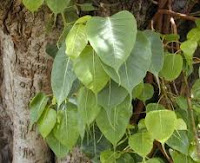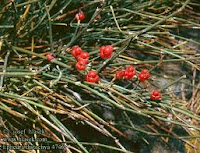 COMMON WORMWOOD, ARTEMISIA ABSINTHIUM, AFSANTIN IN URDU
COMMON WORMWOOD, ARTEMISIA ABSINTHIUM, AFSANTIN IN URDUCommon wormwood is, like
rue one of the bitterest herbs and has gone down in literature as a synonym for bitterness or something which is disagreeable in the extreme. It gets the name
Artemesium from the goddess Artemis who was also the Roman goddess Diana. Legend has it that she found the
Artemisia herbs and gave them to Chiron the centaur so that he could practise medicine. The Greek word ‘
apsinthon’ means without pleasure, which is probably a reference to wormwood’s bitterness.
The plant has a tall flowering stem which can grow to 2½ feet tall and has silky white hairs on it and green-yellow flowers in July through to October. It likes shady places and is native to Britain, unlike the Roman Wormwood. Of all the wormwoods this Common one is the strongest and most bitter. It’s best to gather the tops when they are in flower and make a tisane with them, so you don’t become nauseous as you can if you make an infusion with the large leaves at the base of the plant. You can dry these flowering tops and store them for later use.

Wormwood has been used in medicine for thousands of years and is mentioned in the Eber’s Papyrus, one of the oldest existing Egyptian herbals, dating from about 1552 BC. The ancient Egyptians used it for menstrual problems, for fevers, as a tonic and antiseptic. It was used by both Pliny and Dioscorides, who employed it to get rid of internal worms and for the digestion. In the Middle Ages in Europe it was used to remove tapeworms from the gastrointestinal tract. It is still used in parts of Italy today to stimulate the appetite, and in Pakistan it is used by the traditional healers, or
hakims for liver problems, including hepatitis, to purify the blood, for jaundice, diabetes, skin diseases, to cure allergies, nausea and vomiting as well as a remedy for tetanus and as a brain tonic.
The flowering tops have been preferred through the ages as they are not as strong or bitter as the rest of the plant, although the whole plant can be used. The base leaves which form before the stalk appears make a strong potion, and some of the old herbalists recommended these leaves for their infusions and tinctures. The ancient Greeks and Romans believed that wormwood was an antidote for poisoning by toadstools,
hemlock and bites from Sea Dragons. It is also supposed to be good for flatulence, and epilepsy as well as a wonderful digestive aid.

There has been quite a lot of research done on
A.
absinthium, perhaps because of the notoriety it had in the late 19
th and early 20
th centuries when it was used to make absinthe, the liqueuer that was subsequently banned in many countries. However it would seem that this infamy was undeserved, as it is neither a hallucogen nor addictive. However if you take an infusion of it the recommended daily dose is low, three wineglassfuls a day. It contains thujone which has a recommended daily dose of 3 milligrams and it should only be taken for a maximum of two weeks. Like the oil of the
Chaste Tree, it contains pinene too.
It may help patients with Crohn’s Disease, as it was reported in one small study that it has a “steroid-sparing effect” and improved the mood and quality of life of patients with that disease. It has potent antioxidant activities, and so research is underway to see if it can be used as a base for anti-cancer drugs. The freshly extracted volatile oil from the plant has anti-bacterial effects on some strains of bacteria, and it is effective against candida or thrush.
It was believed that if wormwood was carried around the waist it would protect against harm, and it was used in psychic and spiritual work, to invoke benign spirits. The Physicians of Myddfai used it, mainly in combination with other herbs for a number of illnesses. Here are some of their remedies. The first is for fevers.

“There are four kinds of fevers, deriving their origin from the summer, viz. latent fever, intermittent fever, ephemeral fever, and inflammatory fever. The fifth fever is typhus, and this kind proceeds from the brain. A latent fever is relieved by an emetic, a cordial, and cauteries. Thus it originates; from the over generating of tough humor in the stomach, from which results a distaste for food, and lassitude during summer. The
mugwort,
madder,
meadow sweet, milfoil, hemp,
red cabbage, and the
tutsan, all these seven herbs enter into the composition of the medicine required. Whosoever obtains them all, will not languish long from a wounded lung, or need fear for his life. Any of the following herbs may be added thereto,
butcher's broom,
agrimony, tutsan,
dwarf elder,
amphibious persicaria,
centaury, round birth wort,
field scabious,
pepper mint,
daisy,
knap weed, roots of the red nettle, crake berry,
St. John's wort,
privet,
wood betony, the roots of the
yellow goat's beard, heath,
water avens,
woodruff, leaves of the
earth nut, agrimony, wormwood, the
bastard balm, small burdock, and the
orpine.
Thy also believed in fasting and had different advice for each month; here is their advice for May: -
“Do not eat sheep's head or trotters, use warm drink. Eat twice daily of
hart's tongue, fasting. Take a gentle emetic. Use cold whey. Drink of the juice of
fennel and wormwood.”

They also thought that it would be beneficial as an antidote to a snake bite, (adders are the only native British snake)
“For the bite of an adder. Mix the juice of the fennel, of radish, rue or wormwood, with oil, let the patient drink the same, or eat it.”
The next remedy was for “ague” or fever, but the prayer or pater noster was to be said, perhaps in case the remedy didn’t work.
“Drink the juice of rue in wine, swallow three grains of
coriander, drink
celery (apnium) in water, (sweetened,) and collect
plantain whilst saying your pater noster, and drink it infused in wine and
pepper. Take the juice of the mugwort bruised, the juice of the wormwood, and tepid oil. Then anoint your whole body on one side three days successively, and it will cure the ague for you cheap.”
Apart from being used in the making of absinthe, which is seeing a revival in the 21st century, it is used in Italian Vermouth and in bitters which are used to aid digestion and cure hangovers. It was also used before hops for brewing beer.
Some superstitions about wormwood were about seeing your future spouse if you took
marigold flowers, a sprig of
marjoram,
thyme and a little wormwood, dried them in front of a fire and ground them together to a fine powder which was sifted through a piece of lawn, then mixed this with virgin honey and vinegar, and anointed yourself with it before going to bed on Saint Luke’s day, invoking the saint with these lines

“St Luke, St Luke be kind to me,
In dreams let me my true love see.”
You would see your “true love.”
It is an effective insect repellant, and this verse from Tusser’s “July’s Husbandry” (1557) illustrates this well.
“While wormwood hath seeds get a handful or twaine
To save against March, to make flea to refraine;
Where chamber is sweeped and wormwood is strewne
What saver is better (if physick be true)
For places infected, than wormwood or rue?”
If you put sprigs of wormwood in cloth in drawers or wardrobes, your garments won’t be attacked by moths or other insects.
Wormwood has gone down in literature and is found in the Bible in the Book of Lamentations, Chapter 3 verse 19 as well as elsewhere, and is synonymous with bitterness and misery with gall so we get the phrase “wormwood and gall” in later literature. For example, Hamlet hears this speech of the actor laying the queen in the play within a play
Player Queen: “O confound the rest!
Such love must needs be treason in my breast;
In second husband let me be accurst!
None wed the second but who kills the first!”
Hamlet: “That’s wormwood!” (Act 3 scene 2)
Dickens writing in the 19th century also uses the phrase in “Martin Chuzzlewit” chapter 55 “I have summoned you here to witness your own work… because I know it will be gall and wormwood to you.”
Wormwood preparations should not be used for young children, pregnant or lactating women, or people with severe liver or kidney diseases.
WORMWOOD TISANE
Ingredients
1 oz of the flowering tops of wormwood
1½ pints boiling water
Method
Put the herb in a pan and cover with the boiling water. Leave to steep for 10 minutes then strain and set some aside for later use.
Drink only a wineglassful for digestion, or to calm down. You might want to add honey or other herbs to this, as it is bitter, but warming and aromatic.
This has Taste and is a Treat(ment).
 ½ kilo potatoes peeled and boiled whole in salted water.
½ kilo potatoes peeled and boiled whole in salted water.

















































